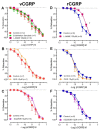Vampire Venom: Vasodilatory Mechanisms of Vampire Bat (Desmodus rotundus) Blood Feeding
- PMID: 30626071
- PMCID: PMC6356263
- DOI: 10.3390/toxins11010026
Vampire Venom: Vasodilatory Mechanisms of Vampire Bat (Desmodus rotundus) Blood Feeding
Abstract
Animals that specialise in blood feeding have particular challenges in obtaining their meal, whereby they impair blood hemostasis by promoting anticoagulation and vasodilation in order to facilitate feeding. These convergent selection pressures have been studied in a number of lineages, ranging from fleas to leeches. However, the vampire bat (Desmondus rotundus) is unstudied in regards to potential vasodilatory mechanisms of their feeding secretions (which are a type of venom). This is despite the intense investigations of their anticoagulant properties which have demonstrated that D. rotundus venom contains strong anticoagulant and proteolytic activities which delay the formation of blood clots and interfere with the blood coagulation cascade. In this study, we identified and tested a compound from D. rotundus venom that is similar in size and amino acid sequence to human calcitonin gene-related peptide (CGRP) which has potent vasodilatory properties. We found that the vampire bat-derived form of CGRP (i.e., vCGRP) selectively caused endothelium-independent relaxation of pre-contracted rat small mesenteric arteries. The vasorelaxant efficacy and potency of vCGRP were similar to that of CGRP, in activating CGRP receptors and Kv channels to relax arteriole smooth muscle, which would facilitate blood meal feeding by promoting continual blood flow. Our results provide, for the first time, a detailed investigation into the identification and function of a vasodilatory peptide found in D. rotundus venom, which provides a basis in understanding the convergent pathways and selectivity of hematophagous venoms. These unique peptides also show excellent drug design and development potential, thus highlighting the social and economic value of venomous animals.
Keywords: Desmodus rotundus; calcitonin gene-related peptide; potassium channels; vampire bat; vasodilatation; venom.
Conflict of interest statement
The authors declare no conflict of interest.
Figures




Similar articles
-
Pharmacological characterization of vampire bat-derived CGRP at the human CGRP receptor in the Xenopus oocyte system.Toxicon. 2025 Oct;265:108466. doi: 10.1016/j.toxicon.2025.108466. Epub 2025 Jun 25. Toxicon. 2025. PMID: 40578569
-
Dracula's children: molecular evolution of vampire bat venom.J Proteomics. 2013 Aug 26;89:95-111. doi: 10.1016/j.jprot.2013.05.034. Epub 2013 Jun 5. J Proteomics. 2013. PMID: 23748026
-
Common vampire bat (Desmodus rotundus) abundance and frequency of attacks to cattle in landscapes of Yucatan, Mexico.Trop Anim Health Prod. 2022 Mar 8;54(2):130. doi: 10.1007/s11250-022-03122-w. Trop Anim Health Prod. 2022. PMID: 35258761
-
A review of the diet of the common vampire bat (Desmodus rotundus) in the context of anthropogenic change.Mamm Biol. 2023 Jun 12:1-21. doi: 10.1007/s42991-023-00358-3. Online ahead of print. Mamm Biol. 2023. PMID: 37363038 Free PMC article. Review.
-
Vampire bat plasminogen activator DSPA-alpha-1 (desmoteplase): a thrombolytic drug optimized by natural selection.Haemostasis. 2001 May-Dec;31(3-6):118-22. doi: 10.1159/000048054. Haemostasis. 2001. PMID: 11910176 Review.
Cited by
-
Venom Use in Eulipotyphlans: An Evolutionary and Ecological Approach.Toxins (Basel). 2021 Mar 22;13(3):231. doi: 10.3390/toxins13030231. Toxins (Basel). 2021. PMID: 33810196 Free PMC article. Review.
-
The Fast and the Furriest: Investigating the Rate of Selection on Mammalian Toxins.Toxins (Basel). 2022 Dec 1;14(12):842. doi: 10.3390/toxins14120842. Toxins (Basel). 2022. PMID: 36548740 Free PMC article.
-
The Toxicological Intersection between Allergen and Toxin: A Structural Comparison of the Cat Dander Allergenic Protein Fel d1 and the Slow Loris Brachial Gland Secretion Protein.Toxins (Basel). 2020 Jan 28;12(2):86. doi: 10.3390/toxins12020086. Toxins (Basel). 2020. PMID: 32012831 Free PMC article.
-
Strategies for Heterologous Expression, Synthesis, and Purification of Animal Venom Toxins.Front Bioeng Biotechnol. 2022 Jan 20;9:811905. doi: 10.3389/fbioe.2021.811905. eCollection 2021. Front Bioeng Biotechnol. 2022. PMID: 35127675 Free PMC article. Review.
-
D. russelii Venom Mediates Vasodilatation of Resistance Like Arteries via Activation of Kv and KCa Channels.Toxins (Basel). 2019 Apr 1;11(4):197. doi: 10.3390/toxins11040197. Toxins (Basel). 2019. PMID: 30939844 Free PMC article.
References
-
- Greenhall A.M. Natural History of Vampire Bats. CRC Press; Boca Raton, FL, USA: 2018.
-
- Delpietro H., Marchevsky N., Simonetti E. Relative population densities and predation of the common vampire bat (Desmodus rotundus) in natural and cattle-raising areas in north-east argentina. Prev. Vet. Med. 1992;14:13–20. doi: 10.1016/0167-5877(92)90080-Y. - DOI
-
- Fernandez A.Z., Tablante A., Bartoli F., Beguin S., Hemker H., Apitz-Castro R. Expression of biological activity of draculin, the anticoagulant factor from vampire bat saliva, is strictly dependent on the appropriate glycosylation of the native molecule. Biochim. Biophys. Acta Gen. Subj. 1998;1425:291–299. doi: 10.1016/S0304-4165(98)00082-8. - DOI - PubMed
MeSH terms
Substances
LinkOut - more resources
Full Text Sources
Research Materials

